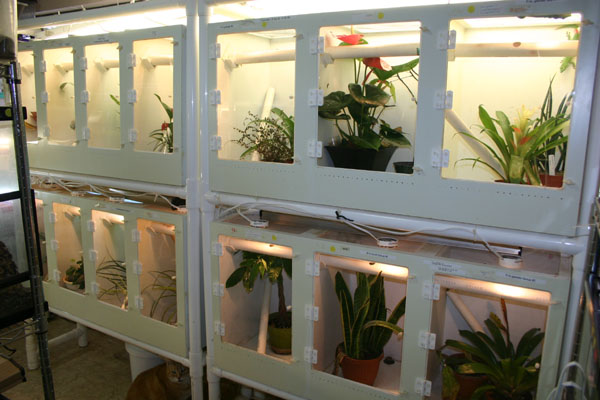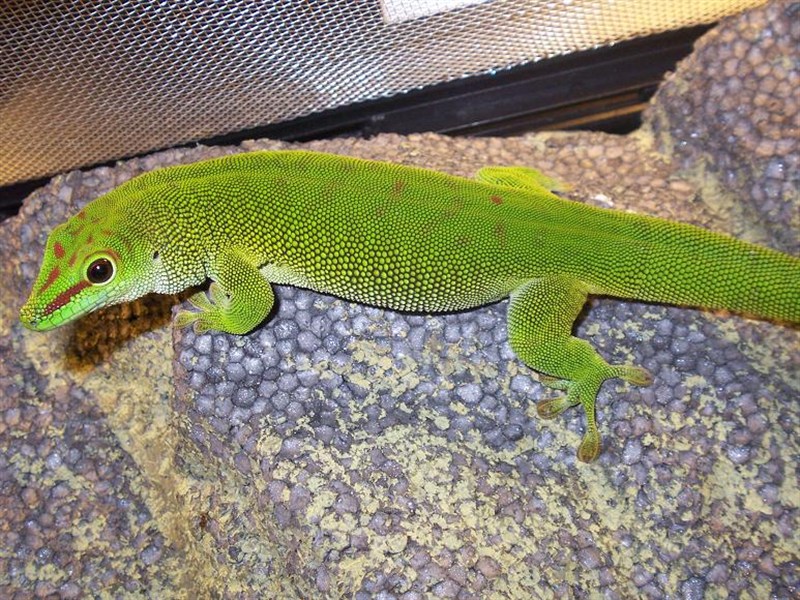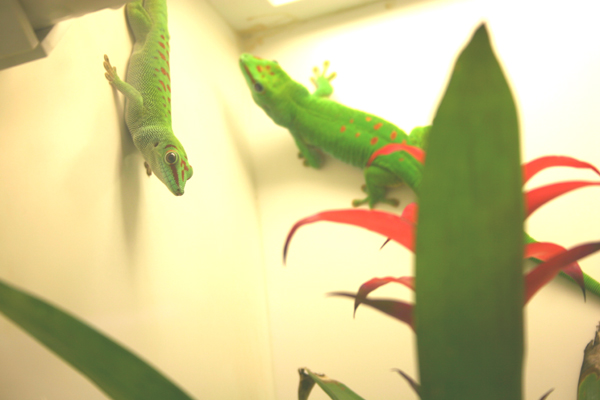Gecko Time nearly always publishes on Tuesday and this Tuesday happens to be Christmas Day, an important holiday for many (though not all) readers. What better way to mark the occasion than to devote this month’s Three to Get Ready to the popular red and green gecko, Phelsuma grandis (get it?)
As always, our three P. grandis experts are responding to the following questions:
1. What morphs are you keeping?
2. What got you interested in this species and where did you get your first one(s)?
3. How are they set up? Describe your enclosure
4. What do you find most interesting about them?
5. What do you find to be the biggest challenge?

Leann Christenson
I keep Phelsuma grandis, formerly known as Phelsuma madagascariensis grandis, and have kept them for many years even before there were any “morphs.” I am a purest so only keep the tradition, original version. Developing morphs brings words up like mutations, genetic alterations, recessive traits, and inbreeding, none of which sounds attractive to me. Instead I concentrate on breeding healthy P. grandis and offspring, and keeping detailed records to track parentage.
I love anything Phelsuma thus P. grandis was an interest. My first came from Tim Tytle, one the most advanced Phelsuma keepers in the world. According to my detailed husbandry records, the first P. grandis hatchings in our facility happened between July 29th, 1996 and September 17th, 1997. Phelsuma grandis were not my favorite large day gecko. I’ve worked with P. standingi (my favorite), P. madagarensis, and P. kochi.
My P. grandis are kept in the biggest enclosure in my facility and nearly identically to the large Gekko gecko habitats: 14x14x25” and 14x12x20”. I use halogen puck lights and the halogen Task Light (brand name). The halogen’s wattage range gives me choices from 10 watts to up to 50 watts. I am able to test how much heat is produced for each enclosure, making it easy to accommodate a single gecko or breeding pair. Enclosures are furnished with tall live sansaveria and branches/cork/bamboo set semi-vertical and horizontal.
The best trait is their brilliant colors! A bonus for me is that the P. grandis are the most researched day gecko ever. They were used in husbandry trials back in the 1970’s for reptile lighting, calcium needs, prepared diets (leading to brands like Repashy’s Meal Replacement Diets), Metabolic Bone Diseases and much more. Fascinating reading!
A huge challenge is in the balance between humidity and heat in a grandis environment. The P. grandis environment is a tight balance between heat and humidity. Too hot and the grandis has skin problems. To dry and the grandis has skin problems. This brings me to my second problem: P. grandis skin. And finally: they can be vicious to fingers they don’t want in their space and to fellow P. grandis in their territory.
Which brings me to my final statement: Although the most readily available day gecko for hobbyist, I would never and will never suggest the P. grandis for a novice keeper. To the amateur reptile keeper unfamiliar with reptile husbandry, the P. grandis is rife with challenges.

Tony Terradas
Like many current-day gecko breeders, I keep and breed several species of geckos – most of which are nocturnal. The appeal of keeping giant day geckos for me has always been that they are large, sociable diurnal lizards meaning they are active during daylight hours when you can enjoy them most. Being brightly colored and active, giant day geckos make excellent display animals. When given enough room, grandis make full use of their setups and are quite inquisitive. While primarily diurnal, giant day geckos tend to be very active at dusk (or when you first turn out their lamps) and this is when I have most frequently heard vocalizations and found my female laying eggs.
Because they have a tendency to be flighty, bordering on spastic, they are not well suited for regular handling, nonetheless, mine will observe me outside their tank likely in hopes that a meal is on its way. These geckos are insatiable when it comes to feeding and enjoy all types of insects from crickets to roaches and the occasional superworm. All Phelsuma are known for having a sweet tooth and giant day geckos are no exception. Mashed up ripe fruits, as well as commercial Repashy Day Gecko Diet and Repashy Crested Gecko Diet are all relished.
My adult pair is housed in an 18”x18”x24” front-opening tank. I have found these to be the best way to house day geckos because when startled they tend to run upward. Anyone who has kept day geckos has undoubtedly had an escapee, or two. I keep a large fish net on hand for that exact reason. Day geckos have delicate skin that tears easily and if you think they’re quick inside their enclosure just wait until they get out. Keeping a net close by can help cut the jailbreak short without having to handle them roughly.
The majority of day geckos can be housed in a similar fashion: vertically oriented tanks with horizontal and/or diagonal bamboo chutes and Sansevieria (snake plants). Other good plants include small indoor palms and pothos. Snake plants are the top choice because they are the preferred egg laying sites for many day geckos and are very hardy. Unharvested eggs can hatch rather easily within the enclosure, but if you want to rear the young you should remove the eggs. Unlike the similarly sized P. standingi, hungry adult grandis won’t think twice about eating their offspring.
I use similarly proportioned 12”x12”x18” front opening enclosures to raise hatchlings and juveniles of similar size. Day geckos are social lizards even at a young age but can be highly territorial, so watch closely for bullying when housing multiple geckos together. Repeated aggression can stress young animals and they may stop eating.
Adult day geckos can be brutally territorial and even fighting between females is quite common. Grandis are best kept in pairs and even then you are not guaranteed a compatible pair. Although grandis are some of the more “gentle” breeders among Phelsuma, it’s important to be able to distinguish between normal breeding wounds and tank-mate aggression. It is common for the male to gently bite the female’s neck or cheek while breeding like in many gecko species. Because their skin is so delicate, many female day geckos end up with a nasty looking bare spot. This is completely normal and the up-side to delicate skin is that it heals quickly.
Wounds to be concerned about are usually found on the flank, tail or limbs. An unreceptive female may be treated like a male intruder if she refuses to breed. If this kind of aggression is observed you should separate them immediately. You can try reintroducing the pair once the female has healed. If you have a compatible pair it is often best to house them together year-round to minimize the chance aggression upon reintroduction.

Julie Bergman
I presently work with about 50 species of geckos, most of them Phelsuma, of which I have about 30 species. Giant Day Geckos, P. grandis, were my first Day Geckos. In the mid-1980s, I saw my first Giant Day Gecko in the local pet shop. I was stunned by her green and red coloration. I had never seen anything quite like it on a lizard! It wasn’t long after I purchased her that I went back to the same pet shop and purchased a mate for her. “Rasta” and “Sargent Bob” went on to produce hundreds of offspring in the many years I had them.
Rasta was an “all green on the back” specimen with the traditional red nose to eye stripe, and a bold red pattern on her head. These all green guys are uncommon. Sargent Bob was the more traditional red pattern on the back kind of guy. Giant Day Geckos do vary quite a bit in appearance by degree of red they have. Many Phelsuma are pretty much color xeroxes of each other, such as P. klemmeri, but there is a lot of variation in Giant Days. It is a bit of reach to say P. grandis has morphs; there are just some that are more red or blue than others. I am starting to get into the bluer specimens. I do have some very red bloodlines, one from my good friends the Lantz’s who developed the Crimson red bloodline, which is pretty consistently red in offspring production. I have a bloodline from Jon Boone that is very red as well, and some of my wild caught have been crossed with both of these bloodlines to make some interesting reds.
I keep mine mostly in a Doug Barr melamine rack purposely built for Phelsuma that has large PVC pipe they can get into and hide or lay eggs. I also put in a large plant or two for cover or to sit on, such as “snake plant” (Sansevieria). Good sitting places are necessary so their heavy tails do not develop a condition called “tail flap.” As with most green geckos from Madagascar, Giant Day Geckos like a basking spot of about 86-88F. I either use “hockey pucks,” 20 watt halogen fixtures found at Home Depot, or full spectrum compact fluorescents. If I use the small halogens I also use some bright utility fluorescents, usually T8s. This way they get the bright light they need, which stimulates their metabolism.
As adults I feed them three week old crickets supplemented with Calcium Plus and gut-loaded with SuperLoad. They also get about once weekly Repashy Day Gecko MRP (Meal Replacement Powder). A few years ago I discovered Phelsuma really liked the flavor combination of fig and cherry when you could buy the MRP flavors separately. After some cajoling from me, Allen Repashy made the Day Geckos their own special food. They will also eat a variety of food items, such as wax worms, hornworms, mealworms and superworms.
The most interesting thing about Phelsuma grandis is the same for all Day Geckos: their amazing bright coloration and their curiosity. They love to see what you are doing, and most will follow your finger along the terrarium glass or even take superworms from your fingers!
The biggest challenge is not in keeping them healthy, that is easy, but convincing others they are one of the best display geckos to keep, period. Giant Day Geckos especially are large, striking geckos. They will always keep you entertained! Many folks are stuck in the belief that a pet, especially a reptile, has to be handleable to be worthwhile. If that was true no-one would buy tropical fish! Giant Days don’t like to be handled and their skin may tear if you handle them roughly. They are to be admired, and will reward you with their long life span (late teens common), beautiful coloration, and interactive behavior.
Julie Bergman is the owner of Gecko Ranch, LLC and has been breeding many species of geckos for over 20 years. She is a frequent contributor to Reptiles Magazine and is the author of the Advanced Vivarium Systems book “Geckos.” You can visit her website at www.geckoranch.com
Leann Christenson is a Gecko and Phelsuma curator at Leaping Lizard Day Geckos. She shares her unique and successful husbandry techniques in the book, Day Geckos In Captivity, articles in the nationally syndicated magazines Reptiles Magazine and Reptile Care, and contributed to Global Gecko Association’s specialized publications, Chit Chat. Changing her direction from the business end of the reptile hobby and industry, she now devotes her time to solving husbandry problems of rare and endangered day geckos. She maintains a popular blog, Frankie Tortoise Tails at www.frankietortoisetails.com
Tony Terradas is the owner of Roc Geckos in Rochester, NY. He grew up catching and learning about local herpetofauna in southern Florida close to the Everglades. Tony’s eventual passion for geckos led him to begin breeding crested geckos and eventually several other species. Tony currently breeds Phelsuma grandis and Phelsuma klemmeri, Coleonyx variegatus and several species of New Caledonian geckos (C. ciliatus, C. sarasinorum, E. agricolae, M. chahoua and R. auriculatus).


One Comment
Leave a ReplyOne Ping
Pingback:Giant Day Gecko Vivarium - Dendroboard